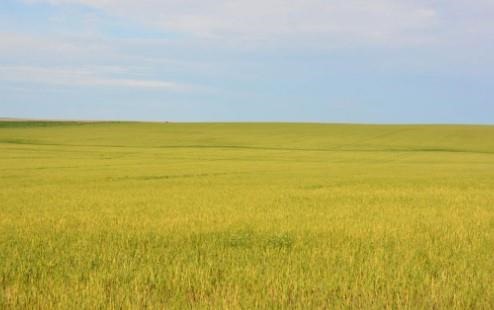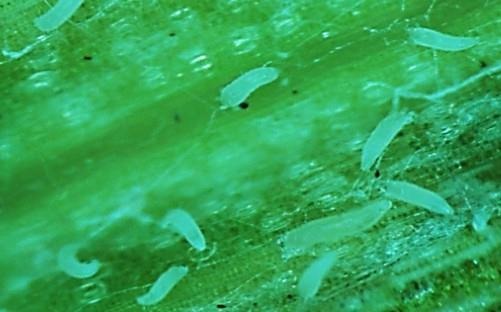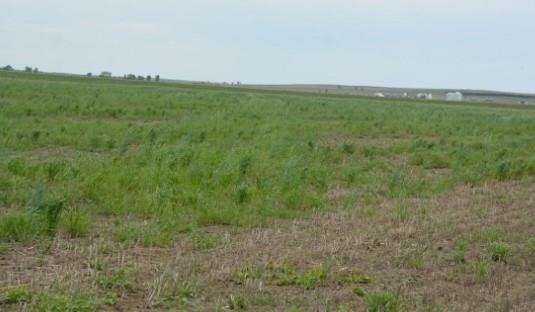By Adam Varenhorst
Wheat streak mosaic virus (WSMV) is one of the important diseases in winter wheat and can lead to severe yield losses. A severe infection of WSMV can lead to the loss of an entire field.
This occurs when the crop is not harvestable due to stunting and sterile wheat heads (Figure 1). However, WSMV can be effectively managed using cultural practices before planting and by understanding the inoculum source, risk factors for development, and using proactive management steps.

Figure 1. A winter wheat with severe yellowing and stunting due to Wheat streak mosaic virus infection.
Wheat streak mosaic virus is transmitted by wheat curl mites, which are microscopic and can only be seen under high (at least 10x) magnification (Figure 2).

Figure 2. Wheat curl mites under magnification.
Wheat curl mites move from field to field by wind. They do not have wings and, therefore, plant to plant movement within a field is limited to wheat located near infested plants. Transmission of WSMV begins in the fall shortly after the winter wheat emerges and continues until dormancy. Fall infections often lead to the greatest yield losses for winter wheat.
Risk Factors for WSMV
The number-one risk factor for WSMD is volunteer wheat and grassy weeds in the field to be planted or in adjacent fields. WSMV can only survive in a living tissue, and wheat curl mites must feed on infected plants to acquire the virus. This indicates that the number-one risk factor for WSMV outbreaks is the presence of over-summering hosts (volunteer wheat, grassy weeds) that ensure the survival of both the virus and wheat culr mites (Figure 3). The over-summering hosts are also known as the “green bridge” between the summer wheat after harvest and the fall-sown winter wheat. Hail events, which lead to grain shattering may lead to early volunteer wheat emergence, which is likely to become infected with WSMV, and will be a source of wheat curl mites and WSMV for the newly emerging winter wheat crop.

Figure 3. Volunteer wheat and grassy weeds in a fallow field. This can become source of wheat streak virus mosaic inoculum for wheat planted into this field or adjacent fields.
Another risk factor for WSMV is planting timing and fall temperatures. If planting is done early to mid-August, the risk for WSMV infection increases. This is because of the movement by the wheat curl mites from recently harvested spring wheat and other small grains and grassy weeds in the area. Mild temperatures through October encourage active movement of the wheat curl mites. Once wheat curl mites have established on wheat during the fall, they will survive the winter as eggs, nymphs or adults protected inside the leaf whorls near the crown, where they can survive harsh winter conditions. The following spring, as wheat greens up, the wheat curl mites become active and multiply. Overcrowding of wheat curl mites on leaves is thought to be one of the factors that leads to wheat curl mite dispersal during the spring. This can lead to new infections stemming from the wheat curl mites feeding on plants that were infected during the fall. If large wheat curl mite populations are present in the spring, it is possible for both winter and spring wheat to be infected by WSMV.
Management of WSMV
Wheat streak mosaic virus and other viruses transmitted by wheat curl mites are best managed through cultural practices performed before planting. Unlike fungal diseases, nothing can be sprayed on virus-infected plants to prevent or cure virus infection. However, several practices can be used to prevent or lessen the chances of wheat getting infected by WSMV.
- Destroy volunteer wheat and grassy weeds at least two weeks before planting this fall. Volunteer wheat and grassy weeds are the most-important risk factor. This two-week period ensures that these hosts are completely desiccated, hence eliminating wheat curl mite populations. If an area is known to have WSMV outbreaks, control of volunteer wheat and grassy weeds would require a communal effort, because wheat curl mites can be carried on the wind up to two miles away from their source field. Volunteer wheat and grassy weeds can be destroyed through tillage or herbicide application.
- Delay winter wheat planting for areas with known high WSMV outbreaks. Planting early in the fall increases the risk of wheat curl mites landing and transmitting viruses in emerging winter wheat. Delayed planting also ensures that summer crops will have matured and dried down, hence reducing chances of wheat curl mites moving from these crops to newly planted winter wheat.
- Plant wheat varieties that are resistant/tolerant to WSMV. Some winter wheat varieties show consistent differences between wheat varieties in terms of grain yield, reduced symptoms and the extent of virus replication in a cultivar. Rating of varieties against WSMV and other diseases can be found in the latest Winter Wheat Variety Trial Results.
- Practice crop rotation. The wheat curl mites can survive on other cereal crops, like corn, millet, barley, and sorghum. Therefore, for areas with frequent WSMV epidemics, planting non-host broad-leaf crops like field peas, lentils, sunflower etc. will help keep WSMV pressure low.
The wheat curl mites only die out if they do not have hosts, like volunteer wheat or other grassy hosts. They do not die out during the winter. Therefore, in situations where these volunteer grassy hosts overwinter, spring wheat planted into or near those areas in the spring can also be at risk of infection. Eliminating volunteer winter wheat and other grassy weed species that could host wheat curl mites at least two weeks prior to planting winter wheat is an important step in reducing risk of this viral disease. However, weeds in fields being planted back to spring wheat next spring should also be cleaned up in the fall.
Source : sdstate.edu